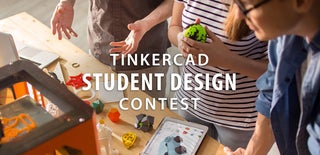Introduction: 3D Printed Fidget Spinner (For Make It Move)
One day, I was lying in my bed, playing with my fidget spinner when a thought crossed my mind: "Wouldn't it be so cool if I could 3D print one of these?" And so my quest to making a fidget spinner began.
Supplies
The only things that I needed to create this fidget spinner were:
- A laptop
- An Autodesk TinkerCad Account
- A 3D Slicing Software (I used Ultimaker Cura)
- A 3D Printer (I used a Monoprice MP Select Mini v2)
- PLA 3D Printing Filament (I used both black and white to get dual colors on the spinner)
Step 1: Basic Design and Measurements
First, I used my calipers to take measurements of a standard 608 ball bearing to pressure fit into the center of my model. As I started to model a basic design in TinkerCad, I realized that it wouldn't be too hard to create my own ball bearing from scratch. And this way the fidget spinner would be 100% 3D Printed. So I designed a simple bearing with three parts: the outer ring (Green), the inner ring (Red), and the nine balls in between the rings (Yellow).
Step 2: The Bearing
The outer ring was created by a simple cylinder with an overhang on the top and bottom to hold the balls in place. The inner ring was the same process but on a smaller scale. The nine balls were just simple spheres placed appropriately between the rings. Between adjusting the size of the balls to adjusting the thickness of the rings, I designed and printed over 10 iterations of the center ball bearing and finally arrived at a design that worked.
Step 3: Spinner Body
After this, I got to work on the body of the spinner. At first, I simply used various curved shapes from the shape generators panel to create the familiar curved design of fidget spinners. I first created one arm at a time and duplicated it twice to group them together into one. However, this did not yield the look that I was hoping for. So I scrapped this design and looked for a different way to do it. This time, I used the flower shape generator with 3 petals. I achieved the fidget spinner shape by reducing the petal radius and increasing the petal length.
The next challenge was the three bearings that would be used as weights on the three arms of the spinner. At first, I thought I could just print out small cylindrical objects at 100% infill to fit into the spinner. But as soon as I printed and tested this design, I knew it wouldn't work. The weight of the PLA plastic bearings was simply not enough to keep the spinner spinning. I finally decided to encase metal bearings within my spinner so that they couldn't be seen. I achieved this by pausing the print in the middle and pressing the bearings into place. After doing this, the spinner spun much better.
Step 4: Thumb Caps
The next step was to create the thumb caps so that I could hold and spin the fidget spinner at the same time. I simply created a thin cylinder and used a flattened out sphere to create divots for a better grip. I then also duplicated this to get two caps. Next, I made the axles coming from the caps that pressure fit into each other. I eventually ended up having to superglue the two pieces together because they were coming apart easily but after that, they worked perfectly.
Step 5: Add Some Flair
Lastly, I decided to add some flair to the outer body by adding more color. Rather than just having a full black spinner, I decided to pause the print at the beginning and end so that just the bearing covers would be white and the rest would be black. However, I accidentally paused the print too early when switching out the colors the second time. This resulted in an entire white layer at the top of the spinner that gave it a look that I actually liked. I finally printed the thumb caps in white and the spinner was finished.
Step 6: Summary
The spinner was printed entirely in place and spun for a maximum of 25 seconds. Creating this Fidget Spinner was a very fun project. I had so many adversities that I almost gave up multiple times along the way. But nevertheless, I persevered through it and it paid off very nicely. This project was a journey of different ideas and I learned a lot along the way. In the end, I had a fully functional, dual-color Fidget Spinner that was 100% 3D Printed … well almost.

Participated in the
Tinkercad Student Design Contest









